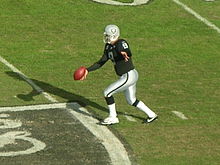Punter (gridiron football)
Accordingly, the most effective punts land just outside the receiving team's end zone and land either out of bounds (making it impossible to advance the ball until the next play) or after being kicked exceptionally high (allowing the kicking team time to run down the field and prevent the punt returner from advancing the ball).One reason for this is that their limited time on the field and heavy protection by penalties against defensive players for late hits makes them far less likely to be injured than other positions.Guy is credited with raising the status of punters in the NFL because he proved to be a major ingredient in the Raiders' success during the 1970s by preventing opponents from gaining field position advantage.The Packers' regular placekicker, Don Chandler, was an All-Pro punter with the New York Giants but Vince Lombardi brought Chandler in from his old team to serve exclusively as a kicker after Paul Hornung, who set the NFL single-season scoring record with 176 points in 12 games in 1960, was suspended for gambling in 1963 and suffered a sharp decline in accuracy in 1964.Steve Spurrier, who was stuck behind John Brodie at quarterback for the San Francisco 49ers, served as the team's primary punter for the first four years of his career.Bob Lee took on the same role for the Minnesota Vikings in the late 1960s and early 1970s, punting for the club in Super Bowl IV.Danny White played little as a backup quarterback to Roger Staubach with the Dallas Cowboys from 1976 through 1979, but was the team's primary punter from 1975 through 1984, when he gave up the kicking duties to Mike Saxon.[6] The New England Patriots were noted for almost exclusively employing left-footed punters during the coaching tenure of Bill Belichick, who claimed it was unintentional.No, punters are now neutralizing and terrorizing the most electric return men in the NFL with kicks that spin and move and bounce and flip in all sorts of unpredictable, terror-inducing ways".



Shane LechlerOakland Raidersgridiron footballspecial teamssnapped ballline of scrimmageCanadian footballrun the footballPunt (gridiron football)Andy Leeend zoneout of boundspunt returnerChicago BearsBrad MaynardplacekickerRobbie Gouldholderfield goallong snapperkickerskickoff specialistsfield goal kickersCraig HentrichSean LandetaJeff Feaglespreseasonindoor American footballBob CameronWinnipeg Blue Bomberscareer punting yardsRay GuyPro Football Hall of FameNFL DraftRussell Erxleben1979 draftNew Orleans SaintsPat O'DeaWisconsinone-platoon systemGreen Bay PackersSuper Bowl ISuper Bowl IIDonny AndersonDon ChandlerNew York GiantsVince LombardiPaul HornungPaul MaguireSan Diego ChargersBuffalo BillsKansas City ChiefsSuper Bowl IVJerrel WilsonJan StenerudSteve SpurrierJohn BrodieSan Francisco 49ersBob LeeMinnesota VikingsDanny WhiteRoger StaubachDallas CowboysMike SaxonZoltán MeskóMichigan Wolverines in 2008Tom TupaAustralian rules footballDarren BennettAustralian Football LeagueBen GrahamNew York JetsSuper Bowl XLIIIArizona CardinalsMat McBriarSav RoccaWashington RedskinsU.S. collegeRay Guy AwardsNCAA Division ITom HornseyMemphisTom HackettMitch WishnowskyMichael Dickson2018 seasonDivision I FBSSam KochNew England Patriotsleft-footedduring the coaching tenureBill Belichick2001 NFL seasonChris Hansondual-footed2017 NFL seasonSB NationYouTubeThe Salt Lake TribuneSports IllustratedAmerican football positionsOffenseLinemanTackleCenterQuarterbackDual-threatGame managerSystemSkill positionsRunning backHalfback/TailbackFullbackH-backWingbackTriple-threatChange of paceWide receiverEligible receiverTight endSlotbackDefenseDefensive tackleDefensive endEdge rusherLinebacker
